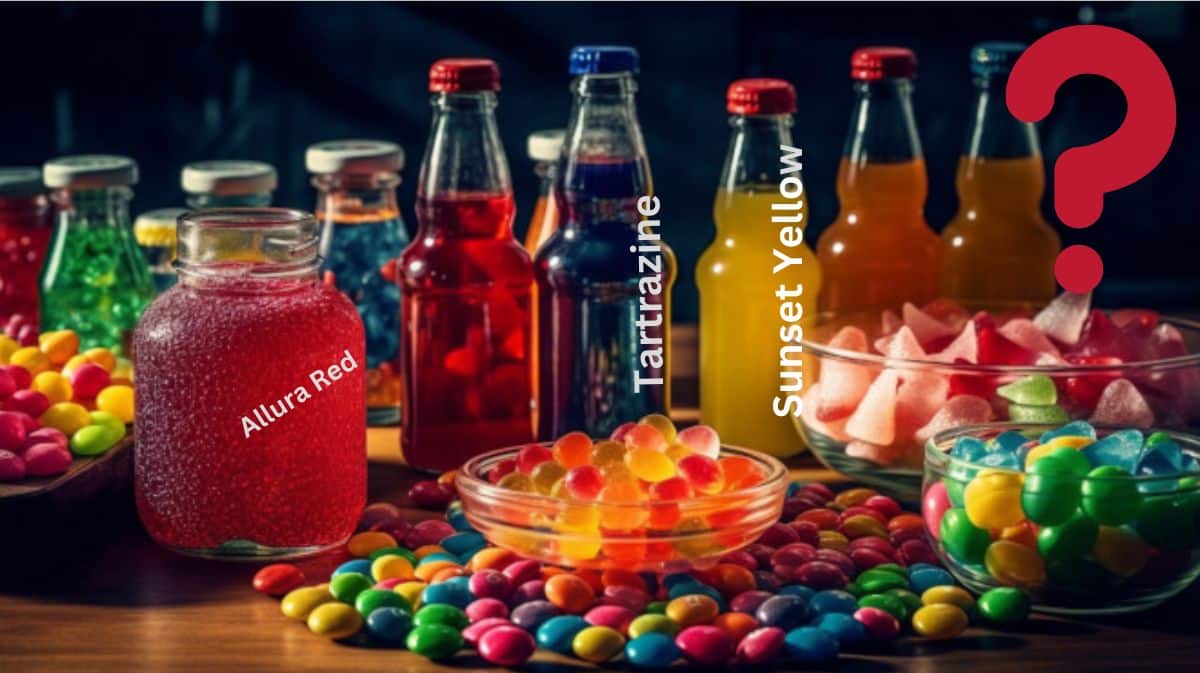Last Updated on July 7, 2024 by Max
Welcome to the Third Part of Our Food Safety Series
Continuing our insightful series on food safety standards, this post shines a light on Azo Dyes – artificial colorings in our food. We examine the vibrant world of these additives, from Allura Red to Sunset Yellow, and delve into the heated debate over their safety. As we contrast the regulatory approaches of the EU and the U.S., join us in uncovering the truth behind these colorful components in our daily diet. When it comes to food, we eat with our eyes as much as with our mouths. The vibrant hues of many candies, beverages, and processed foods are often a result of artificial food colorings, specifically Azo dyes. This group includes well-known names like Allura Red (Red 40), Tartrazine (Yellow 5), and Sunset Yellow (Yellow 6), which are used in the U.S. to make foods more visually appealing (U.S. Food and Drug Administration (FDA), 2020).
The safety of Azo dyes has been a heated debate due to their alleged association with hyperactivity in children and other health concerns (U.S. Food and Drug Administration (FDA), 2020). A pivotal study published in The Lancet suggested that consumption of food containing these dyes could increase hyperactive behavior in children, prompting calls for additional research and regulatory scrutiny (U.S. Food and Drug Administration (FDA), 2020). However, what if these enticing colors came with a cost?
In response to such concerns, the European Union has required warning labels on food and drink products containing these dyes, highlighting children’s potential risk of hyperactivity (European Parliament and Council of the European Union, 2008). Some dyes, like Red 2G (an Azo dye not used in the U.S.), are entirely banned in the EU (European Food Safety Authority (EFSA), 2007).
In contrast, the U.S. FDA maintains that these food colorings are safe for consumption based on their review of available scientific evidence (U.S. Food and Drug Administration (FDA), 2020). They continue to permit their use, burdening proof on demonstrating harm rather than proving safety.
When it comes to food, we eat with our eyes as much as with our mouths. The vibrant hues of many candies, beverages, and processed foods are often a result of artificial food colorings, specifically Azo dyes. This group includes well-known names like Allura Red (Red 40), Tartrazine (Yellow 5), and Sunset Yellow (Yellow 6), which are used in the U.S. to make foods more visually appealing (U.S. Food and Drug Administration (FDA), 2020).
The safety of Azo dyes has been a heated debate due to their alleged association with hyperactivity in children and other health concerns (U.S. Food and Drug Administration (FDA), 2020). A pivotal study published in The Lancet suggested that consumption of food containing these dyes could increase hyperactive behavior in children, prompting calls for additional research and regulatory scrutiny (U.S. Food and Drug Administration (FDA), 2020). However, what if these enticing colors came with a cost?
In response to such concerns, the European Union has required warning labels on food and drink products containing these dyes, highlighting children’s potential risk of hyperactivity (European Parliament and Council of the European Union, 2008). Some dyes, like Red 2G (an Azo dye not used in the U.S.), are entirely banned in the EU (European Food Safety Authority (EFSA), 2007).
The story of Azo dyes illustrates the contrasting approaches to food safety regulation in the EU and the U.S. It calls into question whether the right balance is being struck between the sensory appeal of our food and its potential impact on health.
As we delve deeper into the intricacies of food safety standards, we invite your thoughts on this subject. How comfortable are you with consuming foods containing these artificial colorings? Let us continue this colorful discussion in the comments below.
Conclusion: As we wrap up our exploration of Azo Dyes, we’re left pondering the balance between sensory appeal and health impacts. The diverse regulatory views of the EU and U.S. raise important questions about our food choices. What are your thoughts on these vivid additives in our meals? Are you comfortable with their presence in your diet, or do you seek alternatives? Please share your views and join the discussion as we navigate the food safety world.
References
- European Parliament and Council of the European Union. (2008). Regulation (EC) No 1333/2008 of the European Parliament and of the Council of 16 December 2008 on food additives. Brussels.
- European Food Safety Authority (EFSA). (2007). Opinion of the Scientific Panel on food additives, flavourings, processing aids and materials in contact with food (AFC) on a request from the Commission on the use of Red 2G in food. EFSA Journal, 5(7), 518.
- U.S. Food and Drug Administration (FDA). (2020). Overview of Food Ingredients, Additives & Colors. Washington, D.C.: FDA.
